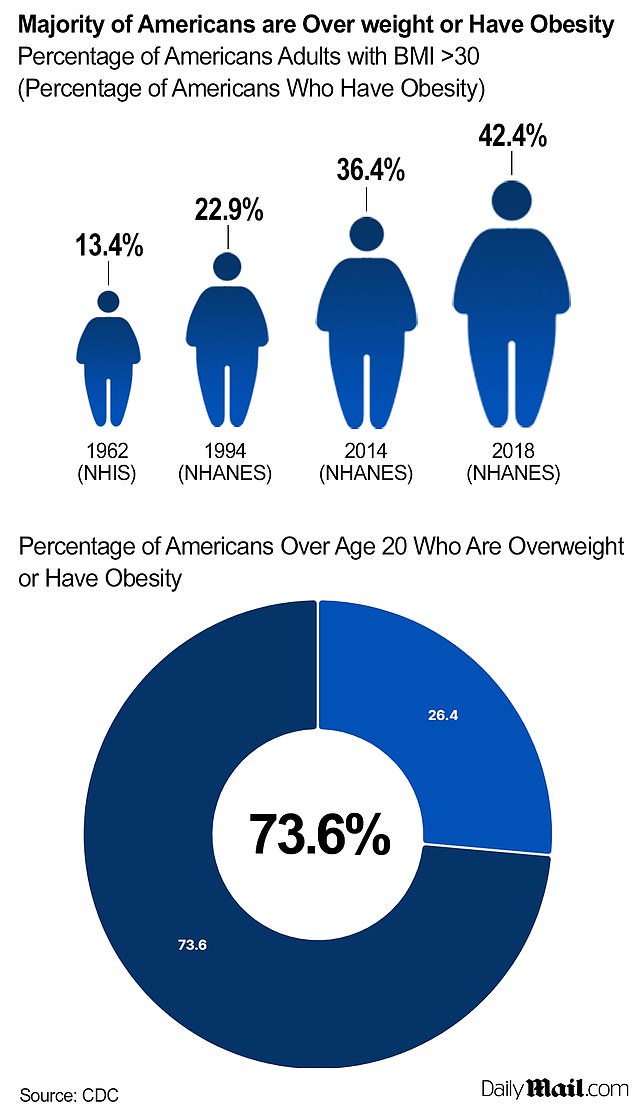Joe Rogan was left speechless after learning a bevy of disturbing realities about Americans’ health on the latest episode of his wildly popular podcast.
Rogan had on two Stanford-trained doctors who reeled off more than a dozen facts about cancer, dementia, autism, infertility and the amount of chemicals in people’s bodies in the US.
Among the most alarming was the fact America is leading the world for cancers in young people and that early-onset dementias have tripled since 2012. The veteran podcaster was stunned to the point of silence but could be heard letting out periodic ‘wow’s’ and heavy exhales.
One of the doctors, Dr Casey Means, a head and neck surgeon from Oregon, said: ‘We are getting destroyed, and it’s very recent and it’s accelerating. The stats speak for themselves.’

Joe Rogan and millions of his listeners learned that US fertility rates are at an all-time low, obesity rates are the highest in the world, and dementia rates among young people are climbing

The doctors sounded the alarm about the high rates of cancer in the US.
Roughly one in two Americans will get cancer in their lifetimes, according to the National Cancer Institute, compared to one in five in China and one in three in Italy.
The global incidence of early-onset cancer has risen 79 percent in two decades, and a staggering one-fifth of Americans has heart disease, compared to a tenth of Europeans.
Dr Means also said that infertility rates among men and women are, on average, rising one percent every year, which could help explain the US’s record-low birth rate, lower than that of France, Ireland, Denmark, and Iceland.
Dr Means told Rogan that the US agricultural industry has been using chemicals on food we buy for years which are banned elsewhere in the world.
Pesticides banned in Europe alone account for over a quarter of the total amount of pesticides used in the US.
Dr Means zeroed in on atrazine, specifically, which is applied to crops like corn, sugarcane, and grain for livestock.
It has the potential to contaminate groundwater when it runs off crops and farmland, and it’s been shown to disrupt hormone systems in wildlife.
It was banned in the EU in 2004.

Dr Casey Means said that while dozens of pesticides have been banned in the EU, those same chemicals are widely used in America’s agricultural industry, which contributes to record-low fertility rates and metabolic disorders
Dr Means said: ‘There are pesticides, actually, where their molecular activity is to increase aromatase, the enzyme that converts testosterone to estrogen.
‘So atrazine, which is banned in Europe, but we spray 70 million pounds of it per year in the US, increases aromatase.
‘Illegal legal overseas, and we buy it from other countries so China and Germany and other countries are selling us a chemical of which 70 million pounds are spread on our food, invisible and tasteless.’

Atrazine is one of roughly 85 herbicides and pesticides that are legal in the US but illegal elsewhere, including the EU and Brazil, and are being phased out in China.
Atrazine and other pesticides have been linked to fertility problems in humans and animals.
The chemicals are known as endocrine disruptors, which means they interfere with the regulation of hormones in the body, which affects estrogen and testosterone.
Meanwhile, glyphosate, a widely used herbicide in the agricultural, garden, and home sectors in the country, was found in 1,885 of 2,310 urine samples, or 82 percent. That included children as young as six.
And despite the mounting evidence across medical specialties that pesticides and herbicides can do considerable harm to human health, use of many of these pesticides has remained relatively steady over the past 25 years despite regulatory actions in other countries.
Several studies have also linked pesticide consumption with low sperm count and quality.
A study of farm workers with frequent exposure to pesticides found that their semen quality was significantly lower than usual, their sperm counts were lower, and the concentration of sperm in semen was abnormally low.
Dr Means said: ‘Infertility is through the roof.
‘We’ve got infertility going up 1 percent per year. Twenty-five percent of men now under 40 have erectile dysfunction.

Dr Calley Means reported that many doctors in the US lack the necessary training to care for women who deal with PCOS, a leading cause of infertility
Researchers have also found that young children, especially toddlers, are exposed to certain chemicals during crucial stages of brain development.
This exposure raises the risk of developmental delays, learning disabilities, lower IQ, and conditions like ADHD.
Delays in children have proven more common in the US – where an estimated 17 percent of children have some sort of developmental and learning issues – compared to Europe, where the average is 10 percent.
Professor Laurie Beyranevand, the director of the Center for Agriculture and Food Systems at Vermont Law School, said: ‘[In the EU] if you can’t demonstrate that [a chemical] is safe, then we’re not going to allow it to be used.
‘Whereas in the United States, we essentially take the approach that if you can’t demonstrate that there’s harm, then we’re going to let you use it.’

The CDC graph shows the total fertility rate peaked during the post-World War II baby boom. By 2018, the TFR had fallen to a record low of 1.73. Since 1971, the TFR has consistently been below the replacement level of 2.10 births per woman, with the exception of 2006 and 2007
Infertility rates are on the rise in the US. There used to be a worldwide birthrate of around five children per woman on average in 1950.
The most recent CDC data showed in 2023, the total fertility rate fell to 1.62 births per woman.
This rate is lower than in European countries and below the fertility rate of 2 that is necessary to keep a population stable.
It effectively means the national US population is in decline.
As more families put off having children until their mid-30s and older to focus on their careers and to become financially stable, many women are missing the biological window to get pregnant.
Infertility rates have been rising for years.
From 2006 to 2010, around 5.8 percent of women struggled with fertility, and that rose to 6.7 percent from 2011 to 2015. By 2017 through 2019 it rose to 8.1 percent.
Now roughly 11 percent of women and nine percent of men have dealt with infertility.
Among those, 10 percent of women aged 15 to 44 have infertility.
This rise reflects several factors, including the large population of baby boomers entering their later reproductive years.
Around 13 percent of women under 30 have trouble conceiving, but that number balloons to 22 percent among women 30 to 39. For comparison, in 2002, around 12 percent of women of all ages had difficulty conceiving.
Dr Calley Means, a former pharmaceutical consultant, also joined the podcast and listed various contributing factors, such as exposure to environmental toxins, poor nutrition, and unhealthy lifestyle choices, which may impact reproductive health.
He added that many doctors lack the necessary training to identify Polycystic Ovary Syndrome (PCOS), a leading cause of infertility.

Dr Calley Means said: ‘Doctors from Harvard Medical School who are OBGYNs do not know, when they’re sitting across from a patient who’s infertile, what causes PCOS.
‘The immediate standard of care is jamming hormone pills down that woman’s throat and on a quick route to IVF.
‘IVF should absolutely of course be legal but that’s an invasive procedure.’
Dementia rates also appear to be rising, even among people under 64.
A report from Blue Cross Blue Shield highlighted alarming increases in the diagnosis of early-onset Alzheimer’s among individuals aged 30 to 64.
Specifically, cases increased by 373 percent in those aged 30 to 44, 311 percent in those aged 45 to 54, and 143 percent in those aged 55 to 64.
Dr Casey Means said: ‘Young adult dementias have increased like three times since 2012.’
Dementia currently has no cure, and Alzheimer’s, the most talked about and common form of dementia, has seen a long history of attempts and even failures to devise medicines that target the right markers of the disease, such as a build-up of harmful proteins in the brain called amyloid.
The EU has similar rates of dementias and Alzheimer’s and, like the US, is expected to see rates to double by 2050.
The reasons for the uptick in young-onset dementias are similar to those believed to be driving early death due to all causes, reproductive issues, and metabolic disorders – a poor diet made up largely of processed foods, largely sedentary lifestyles, alcohol, tobacco, and drug use, and poor access to preventive healthcare that could catch an issue before it advances.

A staggering 74 percent of Americans are overweight, while around 42 percent of that total have obesity, meaning a BMI above 30
Dr Means added: ‘The science is very clear about this it’s basically like all of us are a little bit dead while we’re alive that’s what metabolic dysfunction is it’s less energy in the body.
‘And we could fix it we could fix it really quick quickly if we all popped up and woke up and looked at the data and put pieces together.’
Obesity has become one of the country’s leading public health crises, as 74 percent of adults are overweight, according to the CDC.
That includes nearly 43 percent who have obesity based on body mass index, a measurement of body fat based on weight and height, of 30 or higher.
At the same time, around 13 percent of people in Europe have obesity.
The proportion of adults classified as obese today is more than three times higher than the rate reported by the CDC several decades ago— 13 percent in 1962.
The highest rates of obesity are in middle-aged people. The condition has been known to increase the odds that someone will develop diabetes, arthritis, digestive problems, breast cancer, and colon cancer. It’s also a leading cause of heart disease, the number one killer of Americans.










